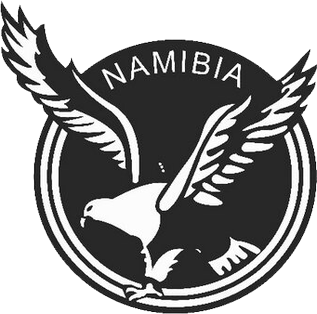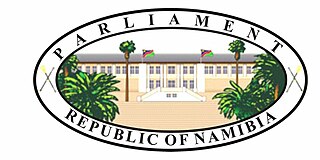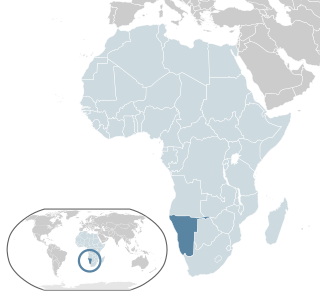Related Research Articles

Namibia, officially the Republic of Namibia, is a country in Southern Africa. Its western border is the Atlantic Ocean. It shares land borders with Zambia and Angola to the north, Botswana to the east and South Africa to the south and east. Although it does not border Zimbabwe, less than 200 metres of the Botswanan right bank of the Zambezi River separates the two countries. Namibia gained independence from South Africa on 21 March 1990, following the Namibian War of Independence. Its capital and largest city is Windhoek. Namibia is a member state of the United Nations (UN), the Southern African Development Community (SADC), the African Union (AU) and the Commonwealth of Nations.

The economy of Namibia has a modern market sector, which produces most of the country's wealth, and a traditional subsistence sector. Although the majority of the population engages in subsistence agriculture and herding, Namibia has more than 200,000 skilled workers and a considerable number of well-trained professionals and managerials.
Telecommunications in Namibia include radio, television, fixed and mobile telephones, and the Internet.

Windhoek is the capital and largest city of Namibia. It is located in central Namibia in the Khomas Highland plateau area, at around 1,700 m (5,600 ft) above sea level, almost exactly at the country's geographical centre. The population of Windhoek in 2020 was 431,000 which is growing continually due to a continued migration from other regions in Namibia.

The Zambezi Region is one of the 14 regions of Namibia. It is located in the north-eastern part of the country. It is largely concurrent with the major Zambezi River where it gets its name from. The region has eight constituencies and its capital is the town of Katima Mulilo. The self-governed village Bukalo is also found in this region. The Zambezi Region had a population of 90,596 in 2011. As of 2020, it had 47,884 registered voters.

Air Namibia (Pty) Limited, which traded as Air Namibia, was the national airline of Namibia, headquartered in the country's capital, Windhoek. It operated scheduled domestic, regional, and international passenger and cargo services, having its international hub in Windhoek Hosea Kutako International Airport and a domestic hub at the smaller Windhoek Eros Airport. As of December 2013, the carrier was wholly owned by the Namibian government. Air Namibia was a member of both the International Air Transport Association and the African Airlines Association.

Omusati is one of the fourteen regions of Namibia, its capital is Outapi. The towns of Okahao, Oshikuku and Ruacana as well as the self-governed village Tsandi are situated in this region. As of 2020, Omusati had 148,834 registered voters.

Namibia uses regions as its first-level subnational administrative divisions. Since 2013, it has 14 regions which in turn are subdivided into 121 constituencies.

The Namibia national football team represents Namibia in men's international football and is controlled by the Namibia Football Association. They have never qualified for the FIFA World Cup but have made three appearances in the Africa Cup of Nations. The team represents both FIFA and Confederation of African Football (CAF).

Oshikundu or Ontaku is a traditional Namibian drink made from fermented millet (mahangu) flour, brans and malted sorghum flour mixed with lukewarm water. It is made from cereal. Ontaku has short life span and it has to be consumed within the same day, preferably within 6 hours once its ready. Ontaku is more common among Aawambo people and in some part of Kavango Region. The knowledge of creating Ontaku has been passed orally from one generation to the other orally, hence existing through generations of Aawambo. It is widely sold in open markets and mostly associated with rural areas and northern Namibia. Oshikundu can be served with porrige also when there is nothing to eat with porrige with it aid in term of in need of beef or soup.

The Parliament of Namibia is the national legislature of Namibia. It is a bicameral legislature and, thus, consists of two houses: the National Council and the National Assembly.
Telecom Namibia Limited, commonly known as Telecom Namibia, is a telecommunications service provider operating in Namibia. It is the national telecommunications operator, established in August 1992 and wholly owned by the Government of Namibia. Telecom Namibia is a commercialised company and a subsidiary of Namibia Post and Telecom Holdings Limited. Telecom Namibia is serving more than 396,000 customers, with 986 employees and annual revenue of more than N$1,5 Billion. It runs the largest digital telecommunication network in Namibia.

The Namibia University of Science and Technology (NUST), formerly known as Polytechnic of Namibia, is a public university located in the city of Windhoek, Namibia. Andrew Niikondo is its acting vice-chancellor. NUST was headed by the founding vice-chancellor Tjama Tjivikua until March 2019. After two acting appointments, Erold Naomab was appointed vice-chancellor in January 2021. The largely ceremonial role of chancellor of the university is held by Peter Katjavivi.

Education in Namibia is compulsory for 10 years between the ages of 6 and 16. There are approximately 1900 schools in Namibia of which 100 are privately owned. Namibian subjects' syllabi are based on the International General Certificate of Secondary Education which is part of Cambridge International. The Constitution directs the government to provide free primary education; however, families must pay fees for uniforms, stationery, books, hostels, and school improvements. Among sub-Saharan African countries, Namibia has one of the highest literacy rates.

Namibia is divided into 14 regions subdivided, which are further subdivided into 121 constituencies. The administrative divisions of Namibia are tabled by Delimitation Commissions and accepted or declined by the National Assembly.
This is an overview of taxes charged to individuals and companies in Namibia.

The government of Namibia consists of the executive, the legislative and the judiciary branches. The Cabinet is the executive organ of government, implementing the laws of the country. It consists of the president, the prime minister and his deputy, as well as the ministers of the Cabinet of Namibia. The legislative organs of government are the National Council and the National Assembly. They make the laws of the country. The judiciary organs of government are the courts. The highest court of Namibia is the Supreme Court. There are also the high courts and lower courts.

The history of the Jews in Namibia goes back a little more than one and a half centuries. Non-existent in Namibia before the 19th century, Jews played an important if minor role in the history of Namibia since that point in time, despite their continuous small population. The most famous Namibian Jew was "businessman, philanthropist and Jewish communal leader" Harold Pupkewitz (1915–2012).

The Namibian Marines Corps is the Naval Infantry of Namibia and is part of the Namibian Navy and the Namibian Defence Force.
References
- ↑ Sasman, Catherine (11 January 2013). "UDF at crossroads". The Namibian . Archived from the original on 21 February 2013.